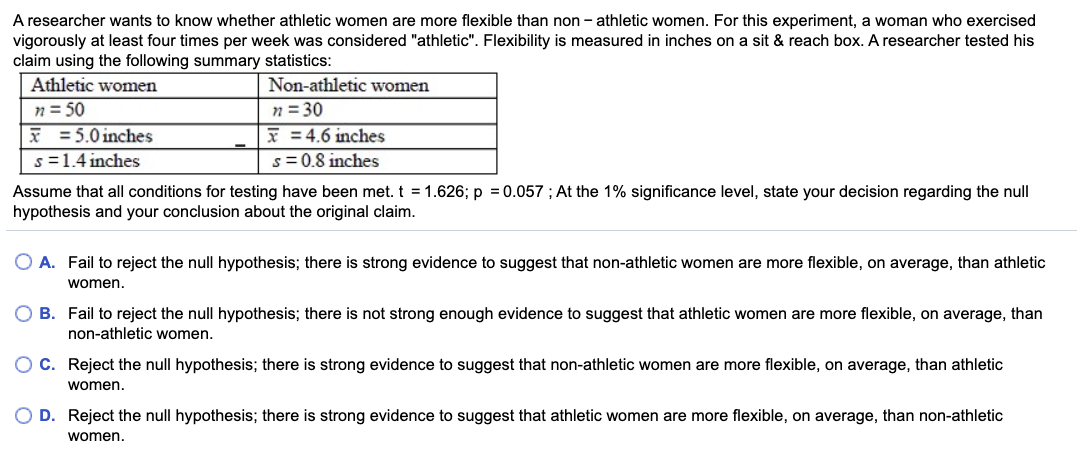A researcher wants to know whether athletic women are more flexible than non - athletic women. For this experiment, a woman who exercised vigorously at least four times per week was considered "athletic". Flexibility is measured in inches on a sit & reach box. A researcher tested his claim using the following summary statistics: Athletic women Non-athletic women n = 50 * = 5.0 inches s=1.4 inches n = 30 x = 4.6 inches s= 0.8 inches Assume that all conditions for testing have been met. t = 1.626; p = 0.057 ; At the 1% significance level, state your decision regarding the null hypothesis and your conclusion about the original claim. O A. Fail to reject the null hypothesis; there is strong evidence to suggest that non-athletic women are more flexible, on average, than athletic women. O B. Fail to reject the null hypothesis; there is not strong enough evidence to suggest that athletic women are more flexible, on average, than non-athletic women. O C. Reject the null hypothesis; there is strong evidence to suggest that non-athletic women are more flexible, on average, than athletic women. O D. Reject the null hypothesis; there is strong evidence to suggest that athletic women are more flexible, on average, than non-athletic women.
A researcher wants to know whether athletic women are more flexible than non - athletic women. For this experiment, a woman who exercised vigorously at least four times per week was considered "athletic". Flexibility is measured in inches on a sit & reach box. A researcher tested his claim using the following summary statistics: Athletic women Non-athletic women n = 50 * = 5.0 inches s=1.4 inches n = 30 x = 4.6 inches s= 0.8 inches Assume that all conditions for testing have been met. t = 1.626; p = 0.057 ; At the 1% significance level, state your decision regarding the null hypothesis and your conclusion about the original claim. O A. Fail to reject the null hypothesis; there is strong evidence to suggest that non-athletic women are more flexible, on average, than athletic women. O B. Fail to reject the null hypothesis; there is not strong enough evidence to suggest that athletic women are more flexible, on average, than non-athletic women. O C. Reject the null hypothesis; there is strong evidence to suggest that non-athletic women are more flexible, on average, than athletic women. O D. Reject the null hypothesis; there is strong evidence to suggest that athletic women are more flexible, on average, than non-athletic women.
Glencoe Algebra 1, Student Edition, 9780079039897, 0079039898, 2018
18th Edition
ISBN:9780079039897
Author:Carter
Publisher:Carter
Chapter10: Statistics
Section10.3: Measures Of Spread
Problem 1GP
Related questions
Question

Transcribed Image Text:A researcher wants to know whether athletic women are more flexible than non - athletic women. For this experiment, a woman who exercised
vigorously at least four times per week was considered "athletic". Flexibility is measured in inches on a sit & reach box. A researcher tested his
claim using the following summary statistics:
Athletic women
Non-athletic women
n = 50
* = 5.0 inches
s=1.4 inches
n = 30
x = 4.6 inches
s= 0.8 inches
Assume that all conditions for testing have been met. t = 1.626; p = 0.057 ; At the 1% significance level, state your decision regarding the null
hypothesis and your conclusion about the original claim.
O A. Fail to reject the null hypothesis; there is strong evidence to suggest that non-athletic women are more flexible, on average, than athletic
women.
O B. Fail to reject the null hypothesis; there is not strong enough evidence to suggest that athletic women are more flexible, on average, than
non-athletic women.
O C. Reject the null hypothesis; there is strong evidence to suggest that non-athletic women are more flexible, on average, than athletic
women.
O D. Reject the null hypothesis; there is strong evidence to suggest that athletic women are more flexible, on average, than non-athletic
women.
Expert Solution
This question has been solved!
Explore an expertly crafted, step-by-step solution for a thorough understanding of key concepts.
This is a popular solution!
Trending now
This is a popular solution!
Step by step
Solved in 4 steps with 3 images

Knowledge Booster
Learn more about
Need a deep-dive on the concept behind this application? Look no further. Learn more about this topic, statistics and related others by exploring similar questions and additional content below.Recommended textbooks for you

Glencoe Algebra 1, Student Edition, 9780079039897…
Algebra
ISBN:
9780079039897
Author:
Carter
Publisher:
McGraw Hill

Holt Mcdougal Larson Pre-algebra: Student Edition…
Algebra
ISBN:
9780547587776
Author:
HOLT MCDOUGAL
Publisher:
HOLT MCDOUGAL

Glencoe Algebra 1, Student Edition, 9780079039897…
Algebra
ISBN:
9780079039897
Author:
Carter
Publisher:
McGraw Hill

Holt Mcdougal Larson Pre-algebra: Student Edition…
Algebra
ISBN:
9780547587776
Author:
HOLT MCDOUGAL
Publisher:
HOLT MCDOUGAL